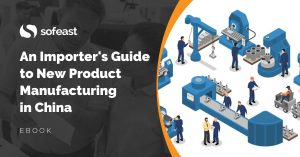Do some of your products include plastic parts? If you purchase hard goods, that’s probably the case.
When writing a guide about plastics manufacturing last month, and I made a list of products that are made in China and incorporate thermoplastics. Here are a few:
- The casing of many electrical appliances and electronic products
- Many vehicle parts (e.g. instrument panels in PVC, a dashboard in ABS, bumpers in PP, cams in PA, buttons in PS…)
- Many construction parts (e.g. countertops, panels, pipes, railings, insulation…)
- Many medical devices (syringes, blood bags, tubes, inhalers…)
- Toys (LEGO, many Mattel figurines, etc.), baby products
- Furniture
Plastic is nearly everywhere! And China makes a large proportion of it. Mold fabrication is particularly inexpensive there, and there is a lot of overcapacity when it comes to injection molding.
Plastic injection molding videos
We made some videos on the plastic injection molding process to help importers understand it better, and I thought I’d share them here.
1. Explanation of the process itself
You will learn about:
- The injection press
- The mold and its components
- Important concepts: daft angle and parting line
- How clamping works – toggle vs. hydraulic clamping
- How the polymer is pushed into the mold (details about the screw mechanism, with a cool animation)
- For more in-depth explanations on the way gates work, you can watch another video
2. The most common thermoplastics used
We cover the most common thermoplastics and their properties:
- ABS
- POM
- Nylon
- PC
- PP
- PBT
- PMMA
- How to select the right polymer for your application?
3. The most common injection molding defects, and how to prevent them
We cover the following typical defects:
- Sink marks
- Weld lines
- Short shots
- Burn marks
- Flash
- Flow lines
- Warping
- Parts sticking inside the mold
4. How to check whether the process is performed correctly
When a client needs extra assurance that all will turn out well, we do some of these:
- Checking the tool design
- Checking the setup of the press
- What equipment is needed for these inspections?
- First off inspection
- Process audit: what to look at when qualifying a potential supplier or when ensuring a current supplier has the right process setup and controls in place
I hope this is useful. We’ll do similar ‘deep dives’ into other processes and/or materials in other articles, over the next few months.
Please add any questions you may have about plastic injection molding or other manufacturing processes as comments here and I’ll be glad to answer them.
Are you designing, or developing a new product that will be manufactured in China?
Sofeast has created An Importer’s Guide to New Product Manufacturing in China for entrepreneurs, hardware startups, and SMEs which gives you advance warning about the 3 most common pitfalls that can catch you out, and the best practices that the ‘large companies’ follow that YOU can adopt for a successful project.
It includes:
- The 3 deadly mistakes that will hurt your ability to manufacture a new product in China effectively
- Assessing if you’re China-ready
- How to define an informed strategy and a realistic plan
- How to structure your supply chain on a solid foundation
- How to set the right expectations from the start
- How to get the design and engineering right
Just hit the button below to get your copy (please note, this will direct you to my company Sofeast.com):

![All about Plastic Injection Molding and Thermoplastics [Videos]](https://qualityinspection.org/wp-content/uploads/2019/06/AllaboutPlasticInjectionMoldingandThermoplasticsVideos.jpg)
